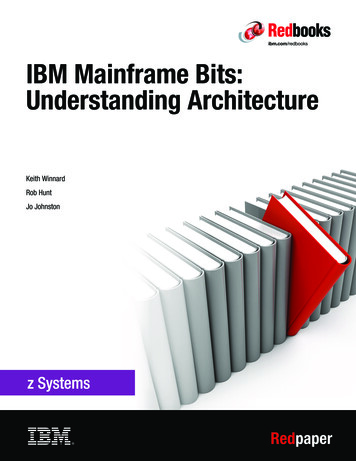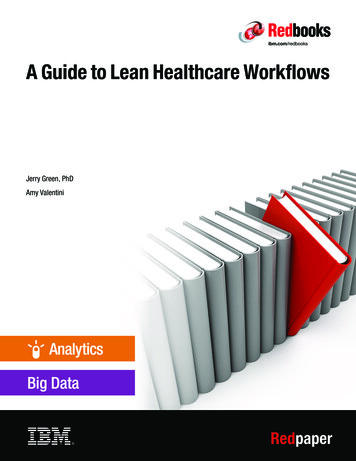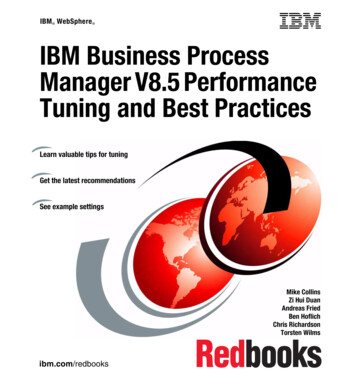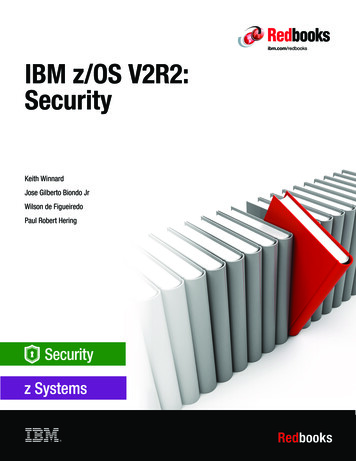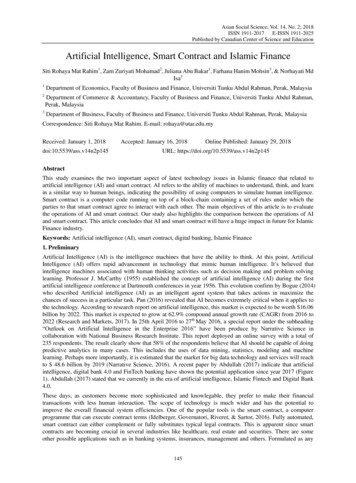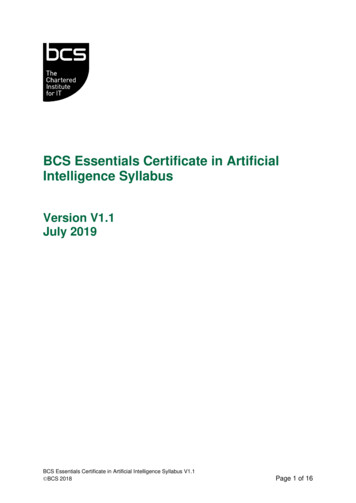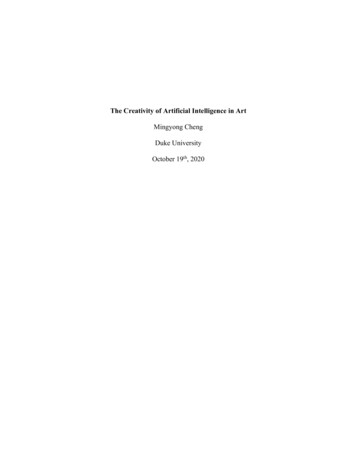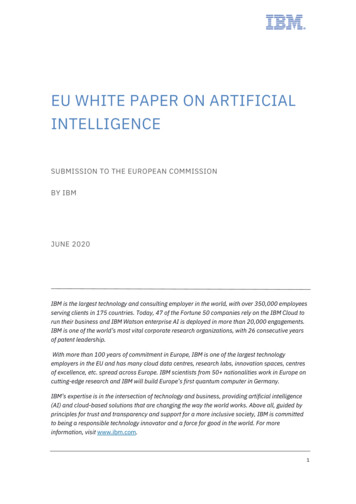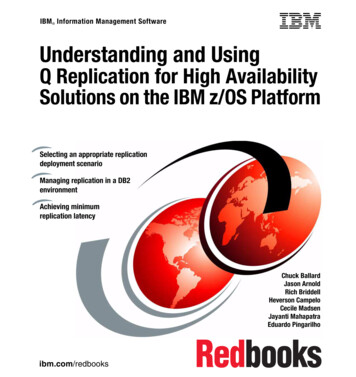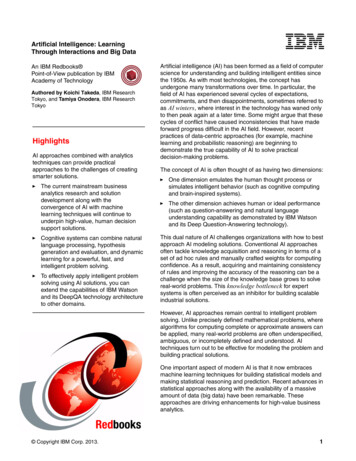
Transcription
Artificial Intelligence: LearningThrough Interactions and Big DataAn IBM Redbooks Point-of-View publication by IBMAcademy of TechnologyAuthored by Koichi Takeda, IBM ResearchTokyo, and Tamiya Onodera, IBM ResearchTokyoHighlightsAI approaches combined with analyticstechniques can provide practicalapproaches to the challenges of creatingsmarter solutions. The current mainstream businessanalytics research and solutiondevelopment along with theconvergence of AI with machinelearning techniques will continue tounderpin high-value, human decisionsupport solutions. Cognitive systems can combine naturallanguage processing, hypothesisgeneration and evaluation, and dynamiclearning for a powerful, fast, andintelligent problem solving. To effectively apply intelligent problemsolving using AI solutions, you canextend the capabilities of IBM Watsonand its DeepQA technology architectureto other domains.Artificial intelligence (AI) has been formed as a field of computerscience for understanding and building intelligent entities sincethe 1950s. As with most technologies, the concept hasundergone many transformations over time. In particular, thefield of AI has experienced several cycles of expectations,commitments, and then disappointments, sometimes referred toas AI winters, where interest in the technology has waned onlyto then peak again at a later time. Some might argue that thesecycles of conflict have caused inconsistencies that have madeforward progress difficult in the AI field. However, recentpractices of data-centric approaches (for example, machinelearning and probabilistic reasoning) are beginning todemonstrate the true capability of AI to solve practicaldecision-making problems.The concept of AI is often thought of as having two dimensions: One dimension emulates the human thought process orsimulates intelligent behavior (such as cognitive computingand brain-inspired systems). The other dimension achieves human or ideal performance(such as question-answering and natural languageunderstanding capability as demonstrated by IBM Watsonand its Deep Question-Answering technology).This dual nature of AI challenges organizations with how to bestapproach AI modeling solutions. Conventional AI approachesoften tackle knowledge acquisition and reasoning in terms of aset of ad hoc rules and manually crafted weights for computingconfidence. As a result, acquiring and maintaining consistencyof rules and improving the accuracy of the reasoning can be achallenge when the size of the knowledge base grows to solvereal-world problems. This knowledge bottleneck for expertsystems is often perceived as an inhibitor for building scalableindustrial solutions.However, AI approaches remain central to intelligent problemsolving. Unlike precisely defined mathematical problems, wherealgorithms for computing complete or approximate answers canbe applied, many real-world problems are often underspecified,ambiguous, or incompletely defined and understood. AItechniques turn out to be effective for modeling the problem andbuilding practical solutions.One important aspect of modern AI is that it now embracesmachine learning techniques for building statistical models andmaking statistical reasoning and prediction. Recent advances instatistical approaches along with the availability of a massiveamount of data (big data) have been remarkable. Theseapproaches are driving enhancements for high-value businessanalytics.Redbooks Copyright IBM Corp. 2013.1
According to Bernard Meyerson, Chief InnovationOfficer, IBM, the DeepQA technology of IBM Watson “isjust a first step into a new era of computing that’s goingto produce machines that are as distinct from today’scomputers as those computers are from themechanical tabulating devices that preceded them.”1As organizations embrace AI, understanding themethods to approaching intelligent problem solving iscentral to gaining an advantage with AI solutions.AI and business analytics drivesmarter solutionsMachine learning and statistical or predictive analysis,in many cases, boils down to business analytics, whichis a core component of contemporary AI. Thus,business analytics are central to the AI-relatedactivities that build a smarter solution. When youapproach methods to use AI technologies, consider thefollowing AI-related activities:doctor can better determine possibilities for treatment.In turn, better data might help reduce unnecessarytreatments or tests, thus improving patient outcomesand reducing overall costs, for the patient, the practice,and ultimately, the healthcare industry, while alsomaking processes more efficient.In another example, a cognitive computing assistant,such as IBM Watson Engagement Advisor, can help abusiness to better serve its consumers. Thistechnology allows brands to crunch big data andtransform the way that they engage clients in keyfunctions, such as customer service, marketing, andsales. IBM Watson Engagement Advisor can learn,adapt, and understand a company’s data, enablingcustomer-facing personnel to assist consumers withdeeper insights more quickly than previously possible.Other examples of adapting AI technologies to otherindustries might be the deployment of speechrecognition and voice command interpreters tosmartphones, consumer electronics, and automotivesand the application of computer vision to robots. Adapting AI technologies to other industries Applying cognitive computing to mind-likecomputational models Converging AI and business analytics Incorporating operational intelligence into expertintegrated systemsAdapting AI technologies to otherindustriesAn AI program can use natural language capabilities,hypothesis generation, and evidence-based learning toproduce a better outcome. Researchers are nowlooking at advances in technologies to leverage AI inother industries. Facts strongly suggest that thequestion and answer architecture behind the AItechnology that made IBM Watson possible can beapplied to other domains. If quality information sourcesare available and a reasonable set of sample questionsand answers for the domain exists and if the deeplinguistic analysis for the source language is available,this type of technology can adapt well to otherindustries.For example, the core technology behind AI can helptransform the way a doctor interacts with a patient. Byfeeding data to an AI program, such as IBM Watson, ange-the-world-within-five-years.htmlA system that generates hypotheses canrecognize different probabilities of variousoutcomes. It can “learn” from successes andfailures and can improve future responses.Applying cognitive computing tomind-like computational modelsCognitive computers move beyond simple processingof data and begin to learn through experiences. Byapplying cognitive computing, models can findcorrelations, can create hypotheses, and then learnfrom the outcomes. This process is fundamentalresearch for building the coherent and unified model ofmind-like computation. Potentially, the resulting modelcan be applied to solve massive sensory informationprocessing and cognitive problems.Researchers at IBM have been working on a cognitivecomputing project called Systems of NeuromorphicAdaptive Plastic Scalable Electronics (SyNAPSE). Byreproducing the structure and architecture of thebrain—the way its elements receive sensory input,connect to each other, adapt these connections, andtransmit motor output—the SyNAPSE project modelscomputing systems that emulate the brain’s computingefficiency, size, and power usage without beingprogrammed.Artificial Intelligence: Learning Through Interactions and Big Data
One of the earlier achievements in the SyNAPSEproject is the (cat-scale) cortical simulations (with 109neurons and 1,013 synapses) that were run by the BlueGene/P supercomputer with 147,456 CPUs and144 TB of total main memory at the LawrenceLivermore National Laboratory.Cognitive systems can transform howorganizations think, act, and operate.Learning through interactions, they deliverevidence-based responses that can drive betteroutcomes.Converging AI and business analyticsRecent empirical AI approaches deploy analyticalmethods—called machine learning—by assuming astatistical model for capturing uncertainty in the givenproblem. Machine learning works by clearly definingbusiness goals, exploring data, and validating anddeploying models. It relies on domain and dataexpertise, rather than analytical skills. This methodestimates a set of parameters of a model (theprobability) from an ample amount of observed datathat approximates the problem space.Machine learning techniques are often theoreticallysound, and various mathematical properties are knownand used to formulate the given problem. Machinelearning approaches are inspired by the advances andsuccess of Business Analytics and MathematicalScience (BAMS) research. BAMS conducts activeresearch in several areas of analytical andmathematical sciences such as optimization,algorithms, stochastic analysis, statistics, data mining,predictive modeling, and simulation.BAMS current projects include a diverse range ofindustry domains, such as retail and banking servicelines, including Supply Chain Management (SCM) andHuman Capital Management (HCM) and solutionareas, such as Smarter Cities and Smarter Energy.Examples of projects that BAMS has executed includecapacity utilization, hiring and training, strategicplanning and budgeting, workforce scheduling,contingency planning, dynamic supply chainoptimization, customer targeting, smarter water supplymanagement for growth markets, propensity modelingfor cross-sell and up-sell, and so forth.For more information about BAMS, vergence of AI and business analytics approachescan further extend the scope of analytics intostructured and unstructured information, humanbehavioral patterns, and interactive learning ofknowledge. The convergence of AI and analyticspromises to model intelligent decision processes.Incorporating operational intelligenceinto expert integrated systemsToday’s applications are complex. They involve adiverse set of hardware and software components thatinteract with each other horizontally and vertically.Optimizing, deploying, configuring, and managingthese components require an enormous amount ofmanual effort by human experts. This tuning process isextremely laborious and error-prone. Automating thisprocess in a cost-effective manner belongs in the realmof applications for artificial intelligence.In the mid 2000s, IBM researchers successfully appliedcontrol theory to software systems, resulting in two keyfeatures in a commercial product: Utility Throttling of DB2 v8.2 Adaptive Self-Tuning Memory of DB2 v9These features made it easier to configure andmaintain databases for all market segments.In mid 2012, IBM delivered PureSystems, a breed ofexpert integrated systems that capture and automatewhat experts do in order to make every part of the ITlifecycle easier. PureSystems uses a semantically richlanguage, developed by IBM Research, to define itsbuilding blocks. The knowledge that formerly sprawledacross hundreds of pages of manuals is now distilledinto a formal representation.As the technology integrates further, expert integratedsystems will evolve by incorporating more usage datafor improving performance and consumability, whichwill eventually be known as operational intelligence.A grocer who is stocking store shelves can usean instrumented glove designed for a cognitivecomputing system that monitors sights, smells,texture, and temperature to flag bad orcontaminated produce.3
For example, healthcare question-answering formedical diagnosis support is one of the most promisingareas for IBM Watson. In October of 2012, IBMannounced a collaboration with Cleveland Clinicclinicians, faculty, and medical students to enhance thecapabilities of Watson’s DeepQA technology for thearea of medicine.2 Watson’s ability to analyze themeaning and context of human language and to quicklyprocess information to provide answers can helphealthcare decision makers use the huge volumes ofinformation generated in their industry. Cleveland Clinicalong with IBM recognized the opportunity for Watsonto interact with medical students to help explore a widevariety of learning challenges that the medical industryfaces today.In February 2013, IBM, WellPoint, Inc., and MemorialSloan-Kettering Cancer Center announced the firstcommercially developed Watson-based cognitivecomputing breakthroughs.3 For more than a year, IBMhas partnered separately with WellPoint and MemorialSloan-Kettering to train Watson in the areas ofoncology and utilization management. During this time,clinicians and technology experts have “taught” Watsonhow to process, analyze, and interpret the meaning ofcomplex clinical information using natural languageprocessing, all with the goal of helping to improvehealthcare quality and efficiency.These innovations represent a breakthrough in howmedical professionals can apply advances in analyticsand natural language processing to “big data,”combined with the clinical knowledge base to createevidence-based decision support systems. TheseWatson-based systems are designed to assist doctors,researchers, medical centers, and insurance carriers,and ultimately to enhance the quality and speed ofcare.234Watson forC lientEngagem entSourceAna lytic sInstitutionRetirementIn stitutionalBankingDISCOVER ServicesModelWatson forIndus tryAdvisorSolutionsTechnicalKnowledgeC all CenterBig DataHelp DeskCard iacASK ServicesNLP &MachineLearningWatson ForFina nc ia lS vcs.AdvisorSolutionsDiabetesOnco logyAdvisorSolutionsUtilizationSolutionsWa tson forHe althc areCapabilitiesTo effectively apply intelligent problem solving using AIsolutions, the successful organization must extend thecapabilities of today’s technologies. IBM Watsonrepresents only the beginning of a new way of thinkingabout ways that technology can help us live and workbetter. IBM Watson and its Deep Question-Answering(DeepQA) technology architecture can be applied toother domains or in other languages for QA.From the healthcare industry, the technology behindIBM Watson is expected to branch into other industriesthat rely on analytic solutions to manage unstructureddata, as illustrated in Figure 1.Plat formExtending the capabilities ofIBM Watson and DeepQADECISION arnFigure 1 IBM Watson products and infrastructureNext steps: Leveraging IBMWatson and IBM expertintegrated systemsIBM’s capability in a diverse range of technical fieldssuch as QA, cognitive computing, and businessanalytics with workload optimized systems positionsIBM as a unique trusted partner to achieve trulyintelligent problem solving with optimized platforms.Your organization can now take advantage of thefollowing IBM solutions, which are powered by Watson: IBM Watson Clinical Insights AdvisorDesigned for therapy designers, this solution assistswith efficient trials and reduces time to market withnew cancer therapies. It can help accelerateresearch and insights. IBM Watson Diagnosis and Treatment AdvisorDesigned for oncologists, this solution assists inidentifying individualized treatment options forpatients diagnosed with cancer. It can help improvediagnosis and /pressrelease/40335.wssArtificial Intelligence: Learning Through Interactions and Big Data
IBM Watson Care Review and Authorization AdvisorDesigned for nurses, this solution streamlinesmanual review processes between a physician andhealth plans. It can improve decisions andoutcomes.IBM also offers IBM PureApplication System, a cloudapplication platform that is designed to simplify andaccelerate the deployment of new cloud-basedapplications. PureApplication System supports a broadrange of needs, ranging from traditional enterpriseapplications to mobile, social, and analytics solutions.As data grows more and more complex, a simplerapproach to managing IT is needed. Expert integratedsystems fundamentally change the IT lifecycle byreducing costs, saving time and resources, andspeeding innovation for your enterprise. IBMPureSystem combines the flexibility of ageneral-purpose system, the elasticity of cloud, andthe simplicity of an appliance to provide an expertintegrated system that has the ability to transform theIT lifecycle. IBM Watson At Your Service: New WatsonBreakthrough Transforms How Brands EngageToday’s Connected lease/41122.wss And Now, From I.B.M., Chef Watson, New YorkTimes, 27 Feb bm-exploring-new-feats-for-watson.html?ref technology IBM Watson Progress and 2013 watson-progress-and-roadmap-saxena IBM Journal of Research and Development, “This isWatson”, Vol.56, No.3/4, May-June snumber 6177717These IBM smarter solutions show how technology caninteract with human experts for learning and enhancingthe accuracy, scalability, and speed of decision-making.AI approaches, in addition to analytics techniques, canusher us toward such intelligent systems.Resources for more informationFor more information about the concepts highlighted inthe paper, see the following resources: The Era of Cognitive Systems: An Inside Look atIBM Watson and How it Works, s/redp4955.pdf IBM Smarter Planet erview/ideas/ IBM Analytics for /healthcare/index.html The IBM Next 5 in 5: Our 2012 Forecast ofInventions that Will Change the World Within FiveYears, New York Times, 17 Dec change-the-world-within-five-years.html5
NoticesThis information was developed for products and services offered in the U.S.A.IBM may not offer the products, services, or features discussed in thisdocument in other countries. Consult your local IBM representative forinformation on the products and services currently available in your area. Anyreference to an IBM product, program, or service is not intended to state orimply that only that IBM product, program, or service may be used. Anyfunctionally equivalent product, program, or service that does not infringe anyIBM intellectual property right may be used instead. However, it is the user'sresponsibility to evaluate and verify the operation of any non-IBM product,program, or service.IBM may have patents or pending patent applications covering subject matterdescribed in this document. The furnishing of this document does not give youany license to these patents. You can send license inquiries, in writing, to:IBM Director of Licensing, IBM Corporation, North Castle Drive, Armonk, NY10504-1785 U.S.A.The following paragraph does not apply to the United Kingdom or anyother country where such provisions are inconsistent with local law:INTERNATIONAL BUSINESS MACHINES CORPORATION PROVIDES THISPUBLICATION “AS IS” WITHOUT WARRANTY OF ANY KIND, EITHEREXPRESS OR IMPLIED, INCLUDING, BUT NOT LIMITED TO, THE IMPLIEDWARRANTIES OF NON-INFRINGEMENT, MERCHANTABILITY OR FITNESSFOR A PARTICULAR PURPOSE. Some states do not allow disclaimer ofexpress or implied warranties in certain transactions, therefore, this statementmay not apply to you.This information could include technical inaccuracies or typographical errors.Changes are periodically made to the information herein; these changes will beincorporated in new editions of the publication. IBM may make improvementsand/or changes in the product(s) and/or the program(s) described in thispublication at any time without notice.Any references in this information to non-IBM Web sites are provided forconvenience only and do not in any manner serve as an endorsement of thoseWeb sites. The materials at those Web sites are not part of the materials forthis IBM product and use of those Web sites is at your own risk. TrademarksIBM, the IBM logo, and ibm.com are trademarksor registered trademarks of International Business Machines Corporation in the UnitedStates, other countries, or both. These andother IBM trademarked terms are marked ontheir first occurrence in this information with the appropriate symbol (or),indicating US registered or common law trademarks owned by IBM at the timethis information was published. Such trademarks may also be registered orcommon law trademarks in other countries. A current list of IBM trademarks isavailable on the Web at e following terms are trademarks of the International Business MachinesCorporation in the United States, other countries, or both:IBMILOGInfoSphereRationalRedbooks Redguide RedpaperRedbooks (logo)System zTivoliWebSphereThe following terms are trademarks of other companies:Other company, product, or service names may be trademarks or servicemarks of others.IBM may use or distribute any of the information you supply in any way itbelieves appropriate without incurring any obligation to you.Information concerning non-IBM products was obtained from the suppliers ofthose products, their published announcements or other publicly availablesources. IBM has not tested those products and cannot confirm the accuracy ofperformance, compatibility or any other claims related to non-IBM products.Questions on the capabilities of non-IBM products should be addressed to thesuppliers of those products.This information contains examples of data and reports used in daily businessoperations. To illustrate them as completely as possible, the examples includethe names of individuals, companies, brands, and products. All of these namesare fictitious and any similarity to the names and addresses used by an actualbusiness enterprise is entirely coincidental.Any performance data contained herein was determined in a controlledenvironment. Therefore, the results obtained in other operating environmentsmay vary significantly. Some measurements may have been made ondevelopment-level systems and there is no guarantee that thesemeasurements will be the same on generally available systems. Furthermore,some measurements may have been estimated through extrapolation. Actualresults may vary. Users of this document should verify the applicable data fortheir specific environment.COPYRIGHT LICENSE:This information contains sample application programs in source language,which illustrate programming techniques on various operating platforms. Youmay copy, modify, and distribute these sample programs in any form withoutpayment to IBM, for the purposes of developing, using, marketing ordistributing application programs conforming to the application programminginterface for the operating platform for which the sample programs are written.These examples have not been thoroughly tested under all conditions. IBM,therefore, cannot guarantee or imply reliability, serviceability, or function ofthese programs.This document, REDP-4974-00, was created or updated on June 3, 2013. Copyright IBM Corp. 2013.6
amount of data (big data) have been remarkable. These approaches are driving enhancements for high-value business analytics. Highlights AI approaches combined with analytics techniques can provide practical approaches to the challenges of creating smarter solutions. The current mainstream business analytics research and solution
